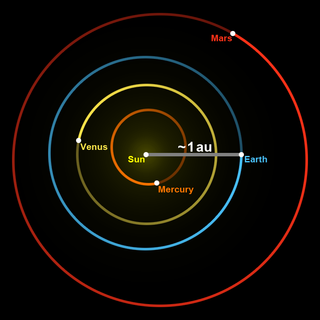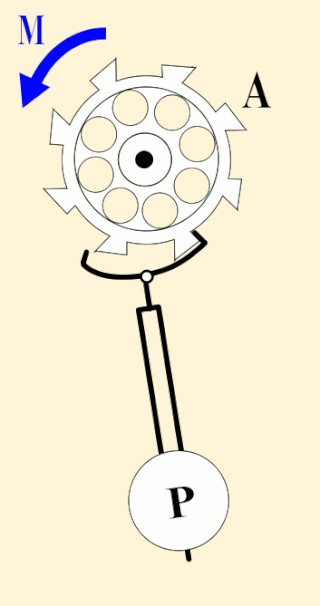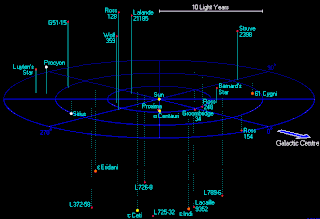Related Research Articles

The astronomical unit is a unit of length defined to be exactly equal to 149,597,870,700 m. Historically, the astronomical unit was conceived as the average Earth-Sun distance, before its modern redefinition in 2012.

The ecliptic or ecliptic plane is the orbital plane of Earth around the Sun. From the perspective of an observer on Earth, the Sun's movement around the celestial sphere over the course of a year traces out a path along the ecliptic against the background of stars. The ecliptic is an important reference plane and is the basis of the ecliptic coordinate system.
The term ephemeris time can in principle refer to time in association with any ephemeris. In practice it has been used more specifically to refer to:
- a former standard astronomical time scale adopted in 1952 by the IAU, and superseded during the 1970s. This time scale was proposed in 1948, to overcome the disadvantages of irregularly fluctuating mean solar time. The intent was to define a uniform time based on Newtonian theory. Ephemeris time was a first application of the concept of a dynamical time scale, in which the time and time scale are defined implicitly, inferred from the observed position of an astronomical object via the dynamical theory of its motion.
- a modern relativistic coordinate time scale, implemented by the JPL ephemeris time argument Teph, in a series of numerically integrated Development Ephemerides. Among them is the DE405 ephemeris in widespread current use. The time scale represented by Teph is closely related to, but distinct from, the TCB time scale currently adopted as a standard by the IAU.

Right ascension is the angular distance of a particular point measured eastward along the celestial equator from the Sun at the March equinox to the point in question above the Earth. When paired with declination, these astronomical coordinates specify the location of a point on the celestial sphere in the equatorial coordinate system.
The Revised Julian calendar, or less formally the new calendar and also known as the Milanković calendar, is a calendar proposed in 1923 by the Serbian scientist Milutin Milanković as a more accurate alternative to both Julian and Gregorian calendars. At the time, the Julian calendar was still in use by all of the Eastern Orthodox Church and affiliated nations, while the Catholic and Protestant nations were using the Gregorian calendar. Thus, Milanković's aim was to discontinue the divergence between the naming of dates in Eastern and Western churches and nations. It was intended to replace the Julian calendar in Eastern Orthodox Churches and nations. From 1 March 1600 through 28 February 2800, the Revised Julian calendar aligns its dates with the Gregorian calendar, which had been proclaimed in 1582 by Pope Gregory XIII.

The second is the unit of time in the International System of Units (SI), historically defined as 1⁄86400 of a day – this factor derived from the division of the day first into 24 hours, then to 60 minutes and finally to 60 seconds each. "Minute" comes from the Latin pars minuta prima, meaning "first small part", and "second" comes from the pars minuta secunda, "second small part".
Terrestrial Time (TT) is a modern astronomical time standard defined by the International Astronomical Union, primarily for time-measurements of astronomical observations made from the surface of Earth. For example, the Astronomical Almanac uses TT for its tables of positions (ephemerides) of the Sun, Moon and planets as seen from Earth. In this role, TT continues Terrestrial Dynamical Time, which succeeded ephemeris time (ET). TT shares the original purpose for which ET was designed, to be free of the irregularities in the rotation of Earth.

A year is the time taken for astronomical objects to complete one orbit. For example, a year on Earth is the time taken for Earth to revolve around the Sun. Generally, a year is taken to mean a calendar year, but the word is also used for periods loosely associated with the calendar or astronomical year, such as the seasonal year, the fiscal year, the academic year, etc. The term can also be used in reference to any long period or cycle, such as the Great Year.
The Julian day is the continuous count of days since the beginning of the Julian period, and is used primarily by astronomers, and in software for easily calculating elapsed days between two events.
A time standard is a specification for measuring time: either the rate at which time passes or points in time or both. In modern times, several time specifications have been officially recognized as standards, where formerly they were matters of custom and practice. An example of a kind of time standard can be a time scale, specifying a method for measuring divisions of time. A standard for civil time can specify both time intervals and time-of-day.
A sidereal year, also called a sidereal orbital period, is the time that Earth or another planetary body takes to orbit the Sun once with respect to the fixed stars.
A solar calendar is a calendar whose dates indicate the season or almost equivalently the apparent position of the Sun relative to the stars. The Gregorian calendar, widely accepted as a standard in the world, is an example of a solar calendar. The main other types of calendar are lunar calendar and lunisolar calendar, whose months correspond to cycles of Moon phases. The months of the Gregorian calendar do not correspond to cycles of the Moon phase.
In astronomy, an epoch or reference epoch is a moment in time used as a reference point for some time-varying astronomical quantity. It is useful for the celestial coordinates or orbital elements of a celestial body, as they are subject to perturbations and vary with time. These time-varying astronomical quantities might include, for example, the mean longitude or mean anomaly of a body, the node of its orbit relative to a reference plane, the direction of the apogee or aphelion of its orbit, or the size of the major axis of its orbit.
The astronomical system of units, formerly called the IAU (1976) System of Astronomical Constants, is a system of measurement developed for use in astronomy. It was adopted by the International Astronomical Union (IAU) in 1976 via Resolution No. 1, and has been significantly updated in 1994 and 2009.

Decimal time is the representation of the time of day using units which are decimally related. This term is often used specifically to refer to the French Republican calendar time system used in France from 1794 to 1800, during the French Revolution, which divided the day into 10 decimal hours, each decimal hour into 100 decimal minutes and each decimal minute into 100 decimal seconds, as opposed to the more familiar standard time, which divides the day into 24 hours, each hour into 60 minutes and each minute into 60 seconds.
In astronomy, an equinox is either of two places on the celestial sphere at which the ecliptic intersects the celestial equator. Although there are two such intersections, the equinox associated with the Sun's ascending node is used as the conventional origin of celestial coordinate systems and referred to simply as "the equinox". In contrast to the common usage of spring/vernal and autumnal equinoxes, the celestial coordinate system equinox is a direction in space rather than a moment in time.
The Gregorian calendar is the calendar used in most parts of the world. It went into effect in October 1582 following the papal bull Inter gravissimas issued by Pope Gregory XIII, which introduced it as a modification of, and replacement for, the Julian calendar. The principal change was to space leap years differently so as to make the average calendar year 365.2425 days long, more closely approximating the 365.2422-day 'tropical' or 'solar' year that is determined by the Earth's revolution around the Sun.

A light-year, alternatively spelled light year (ly or lyr), is a unit of length used to express astronomical distances and is equal to exactly 9,460,730,472,580.8 km (Scientific notation: 9.4607304725808 × 1012 km), which is approximately 5.88 trillion mi. As defined by the International Astronomical Union (IAU), a light-year is the distance that light travels in a vacuum in one Julian year (365.25 days). Because it includes the word "year", the term is sometimes misinterpreted as a unit of time.
A tropical year or solar year is the time that the Sun takes to return to the same position in the sky – as viewed from the Earth or another celestial body of the Solar System – thus completing a full cycle of astronomical seasons. For example, it is the time from vernal equinox to the next vernal equinox, or from summer solstice to the next summer solstice. It is the type of year used by tropical solar calendars.

In lunar calendars, a lunar month is the time between two successive syzygies of the same type: new moons or full moons. The precise definition varies, especially for the beginning of the month.
References
- ↑ P. Kenneth Seidelmann, ed., The explanatory supplement to the Astronomical Almanac, (Mill Valley, Cal.: University Science Books, 1992), pp. 8, 696, 698–9, 704, 716, 730.
- 1 2 "Measuring the Universe". International Astronomical Union . Retrieved March 22, 2012.
- 1 2 International Astronomical Union. "Recommendations Concerning Units". Archived from the original on February 16, 2007. Retrieved February 18, 2007. Reprinted from the "IAU Style Manual" by G.A. Wilkinson, Comm. 5, in IAU Transactions XXB (1987).
- ↑ Harold Rabinowitz and Suzanne Vogel, The manual of scientific style (Burlington, MA: Academic Press, 2009) 369.
- 1 2 Simon Newcomb, Tables of the Four Inner Planets, vol. 6 of Astronomical Papers Prepared for the Use of the American Ephemeris and Nautical Almanac (Washington, DC: 1898), pp. 10–11.